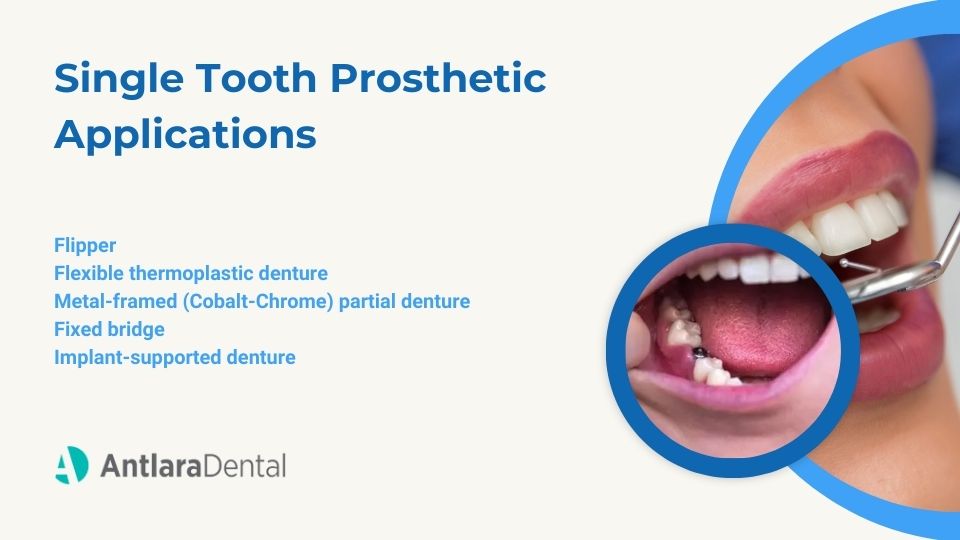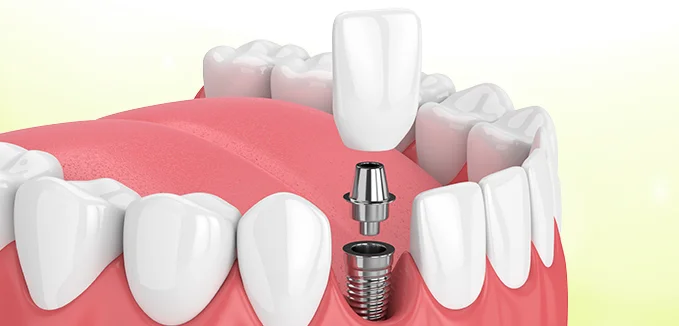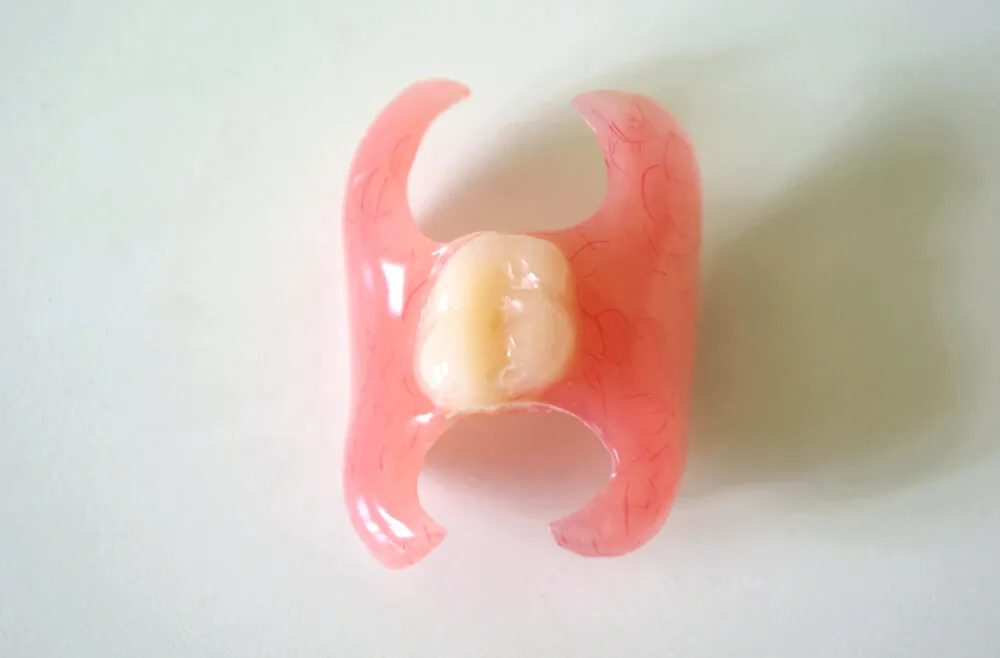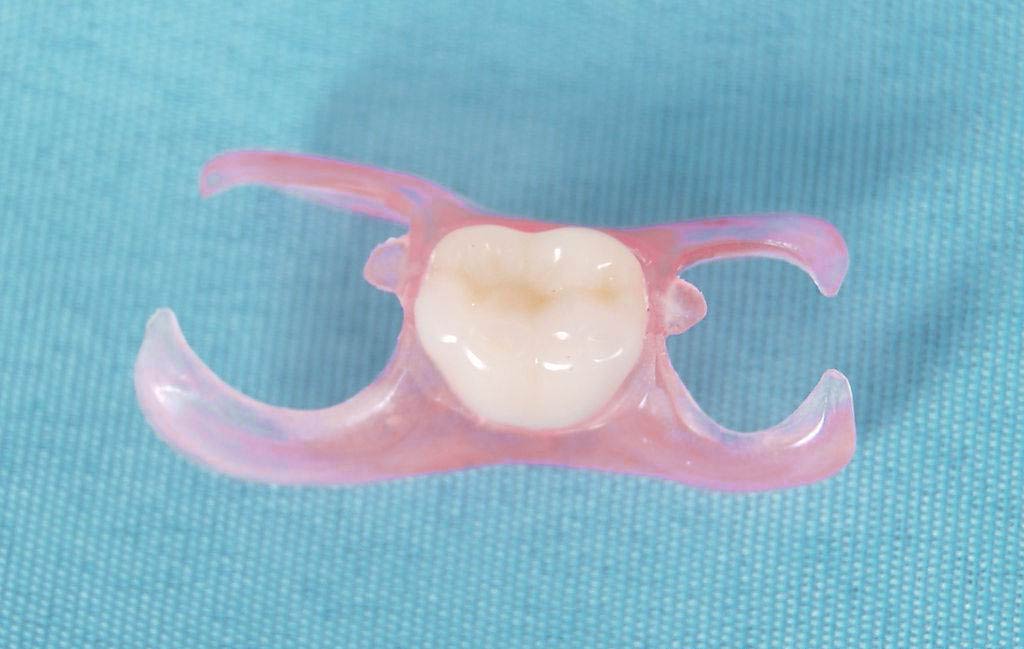A single missing tooth is actually rather common and easy to fix, so there's no need to fret if you're in this situation. Dentists usually recommend several different methods in such cases, the most practical and cost-effective of which is the single-tooth removable prosthesis known as a "flipper".

This prosthesis consists of a single artificial tooth placed on a light gum-coloured base and held in place by tiny hooks that attach to the other teeth in the mouth. You can use it for a short while or keep it for a long time. The space of the missing tooth affects not only the appearance but also the chewing function. Moreover, over time, it can cause neighboring teeth to shift, gingival recession, and jawbone resorption. Therefore, it is very important not to allow even a single tooth to remain missing for a long time to protect oral health.
Single-tooth denture options
When a single tooth is missing, there are several different types of prosthesis available:
Crown with implant support:

It is the most durable and permanent solution. Instead of the tooth root, a porcelain tooth is attached to the implant screwed into the jawbone. It requires a surgical procedure and recovery time, and its cost is high, but it gives results indistinguishable from natural teeth.
Fixed bridge:
A fixed bridge is a long-term solution for replacing a missing tooth. It involves permanently attaching a false tooth to the middle of the bridge and crowning the healthy teeth on either side of the gap. As cutting is required, the neighboring teeth are treated. It does not shield the bone, despite being strong and fixed in the mouth.
Partial denture with metal frame (cobalt-chrome):
These are prostheses with a thin cast metal frame. The hook tips are sometimes visible from the outside, but they provide a very strong fit. They have a longer lifespan (5-10 years or more) and are highly stable in the mouth. The laboratory period is slightly longer, and the cost is higher.
Flexible thermoplastic prosthesis:
Constructed from a specialized biocompatible plastic, it can feature a complete pink hue with transparent edges, eliminating the need for metal clips. Because it is flexible, the mouth fit is comfortable, and the risk of breakage is lower than with acrylic. Because the clips are so small, they don't detract from the aesthetic.
Acrylic (temporary) partial denture (flipper):

The most common and most economical option. It consists of a tooth attached to a pink acrylic base. It is quickly prepared and usually delivered in a few days. Despite its short lifespan (approximately one to three years), cheap cost, and lack of surgical requirement, it is a great option.
Through consultation and testing at your clinic, your doctor will ascertain which of these choices is best for you. In most cases, a permanent implant is the way to go. However, if that isn't possible, other options, like acrylic or a flexible prosthesis, may be more convenient or more affordable.
How much is a denture for a single tooth?
The price of a single denture varies greatly depending on the type of denture chosen, the material and the country. In a nutshell, here is how much they cost:
- UK: Acrylic unifacial partial dentures start at around GBP 695, while partial dentures with a more durable metal base start at around GBP 895. (In London clinics, acrylic partial dentures cost around £695 and metal supported dentures around £895).
- Germany: Prices for single dentures are usually between 300-2000 EUR. This wide range depends on the material of the prosthesis (acrylic, metal, flexible, etc.), laboratory fees and doctor/patient location.
- USA: Single-tooth removable prostheses (flipper teeth) usually cost between 500-1500 USD.
- Turkey: The same high-quality materials and techniques are used in Turkey as in other leading countries. However, due to lower operational and laboratory costs, single dentures typically cost between $200-$350 — making it an affordable option without compromising on quality.
What is a single tooth denture called?
A removable prosthesis for a single missing tooth is often called a "temporary partial denture" or, more commonly, a "flipper denture". In the English literature it is referred to as "single-tooth denture" or "flipper denture". These names come from the structure of the prosthesis, which is a small plate in the form of a single artificial tooth (flipper).
What is the best option for a single missing tooth?
The ideal solution for a single missing tooth is generally considered an implant prosthesis. Implants stimulate the bones, prevent bone resorption, and permanently replace a single tooth without touching neighboring teeth. In the long term, it offers a solid, fixed solution and provides the closest comfort to natural teeth.
In the bridge, the neighboring teeth are filed down a lot and these roots may become prone to decay in the future. It lasts for many years, but since it does not have a bone-protective effect, the bone volume may decrease over time.
The cheapest and fastest solution is removable prostheses, such as a single tooth flipper prosthesis. These do not require surgery and can be removed and replaced. However, the stability is not as high as with implants; the metal clips may loosen or the prosthesis may be uncomfortable.
Can you do a denture for one tooth?
Yes, special prostheses can be made for a single missing tooth. A typical option is a prosthetic that replaces just one tooth, such as a flipper or temporary partial denture. This prosthesis is a special version of a partial denture, which normally covers more than one missing tooth and fills a gap of only one tooth.
A single-tooth prosthesis is like a plate that can be easily inserted and removed in the mouth, similar to a tooth; it can be attached to the upper palate or lower jaw. Therefore, if your teeth are intact, the gap can be closed with a simple removable prosthesis without filing the neighboring teeth for the bridge. While surgical/permanent methods such as implants or fixed bridges are also recommended in single-tooth deficiency, removable prostheses offer a temporary solution if implants are not suitable in terms of cost or health status.
How does a single tooth denture stay in?

The single-tooth prosthesis remains in the mouth with retainers attached around the neighboring teeth. A thin framework, usually made of a metal alloy, is attached to a pink acrylic or flexible plastic retainer. This metal framework is grasped with thin clips and nail-like tips that are placed near the crowns of the intact teeth.
The metal denture frame is passed over the palate of the mouth and inserted into the acrylic to support the dental part of the denture; this frame is then attached to the remaining teeth with metal hooks. This prevents the denture from moving sideways or outwards. In flexible (Valplast etc.) prostheses, transparent thermoplastic clips are inserted into the teeth with a similar logic; since this material is thinner and invisible to the eye, it provides aesthetic advantage especially in the front teeth. In fixed (permanent) bridges or implant-supported prostheses, the retainers are crowns or implant heads fixed on the teeth.
One front tooth denture
Given the greater aesthetic importance of the front teeth, it is crucial that prosthetics for missing front teeth look natural. Anterior dentures are usually made entirely of pink acrylic or flexible plastic, so that the metal parts are largely camouflaged. For example, the pink base is made in the colour of the natural gum and the clips at the edge of the tooth are made thin or covered with a gum-coloured acrylic material.
In addition, some special designs may prefer a bonded bridge, such as the Maryland bridge, where tiny wings are bonded to the back of the tooth, making the prosthesis invisible. Flipper teeth are widely used, especially for missing front teeth, because they are easy to prepare and give aesthetic results. Depending on the patient's wishes, the shape of the gums or the size of the tooth can even be customised.
Single tooth denture vs implant
Implant or prosthesis? The decision depends entirely on your needs, budget and state of health.
An implant is a long-lasting solution that is permanent, feels natural and protects the jawbone. However, it requires surgery, has a recovery period and is costly. In contrast, a single-tooth removable denture (flipper) is a non-surgical, fast and economical alternative. However, they can loosen over time, become less comfortable and may need to be replaced every few years.
In short, the implant comes to the fore if a long-term solid solution is desired. However, if a fast and affordable solution is sought, prosthesis may be more reasonable. Your physician will make the best decision together according to your general health condition and your expectations.
Can you eat with a single tooth denture?
Yes, you can eat with a single denture; the purpose of the denture is to partially restore the missing space in the mouth and thus the chewing function. With flipper-type single dentures, you can chew much better than you would have been able to chew without the denture. However, it is important to remember that these dentures are made of brittle material. It is important not to bite hard, sticky or fibrous foods too hard for the first time and to take precautions to protect the prosthesis.
What does a single-tooth denture look like?
The appearance of a single denture is usually that of a single artificial tooth with a pink body. A typical single denture gives the impression of a single artificial tooth attached to a pink or pink-salmon-colored plastic retainer. Some schematic examples also show metal clips attached to the denture's back, usually hidden behind the other teeth. In a metal-supported prosthesis, two metal tips can be seen through the pink acrylic zone, with the two metal tips inserted into the neighboring teeth.
Sources:
1- Evaluation of a one-piece ceramic implant used for single-tooth replacement and three-unit fixed partial dentures: a prospective cohort clinical trial Ronald E. Jung, Philipp Grohmann, Irena Sailer, Yann-Niclas Steinhart, Aurel Fehér, Christoph Hämmerle, Jörg Rudolf Strub, Ralf Kohal First published: 27 July 2015 https://doi.org/10.1111/clr.12670
